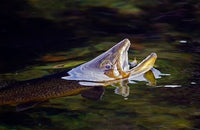
Why Fishing Gets Better When it Turns Dark or Cloudy
Whenever I'm on the river and I see the clouds begin to roll over the mountains, their threats of rain and wind brooding in their dark forms, my heart begins to beat a little faster as I put down my nymphing rig and reach for my dry fly box. It is in the dawning hours of the day, the times when rain clouds threaten and block out the sun, and at dusk when the uninitiated anglers reel in their lines and head for their trucks that the magic starts to happen and the water comes alive!
In the dark hours of the day, the bottoms of our rivers and lakes come to life, and the aquatic invertebrate "Rush Hour" begins. Aquatic invertebrates are hard-wired to survive. Their sole functions in life are to feed, thrive, mate, and pass on their DNA to a healthy swarm of offspring. In order to find the best food - and to avoid seasonal perils such as runoff or low flows - many species of invertebrate will launch themselves away from the safety of the riverbed or lake bottom in hopes of drifting to better options. In waters dominated by hungry fish, after countless millennia of experience, these invertebrates have counted their odds and figured out that their best chance of finding a new home without being picked off by a hungry trout is under the cover of dark.
In addition to the daily migration of invertebrates each dawn and dusk, key transitions in the life-cycle of many of the trout's favorite foods are tied to periods of lesser light. By far one of the most productive and important events for the fly angler is the emergence or "hatch" of aquatic invertebrates. Prompted by season and water temperature, mayfly nymphs, caddis pupa, and midge pupa begin their countdown to launch as the clouds begin to drift over the margins of the sun. Even after as little as 30 seconds of cloud cover, invertebrates will start their clumsy ascent. Where the bugs go, the fish will quickly follow, actively feeding on the emerging invertebrates throughout the water column and on the surface until the lucky survivors are able to fly to safety.
The educated angler can set their watch to these events, anticipating and taking advantage of these clockwork-like feeding frenzies. Fishing fly patterns that imitate both the emerger moving through the water as well as those breaking through the surface can produce explosive results, while standard dry patterns can also be fished with deadly effect. So the next time the clouds roll in and the sun begins to set, let the fair weather anglers head back to their trucks while you tie on your emerger patterns and settle in for some of the best fishing of the day!



